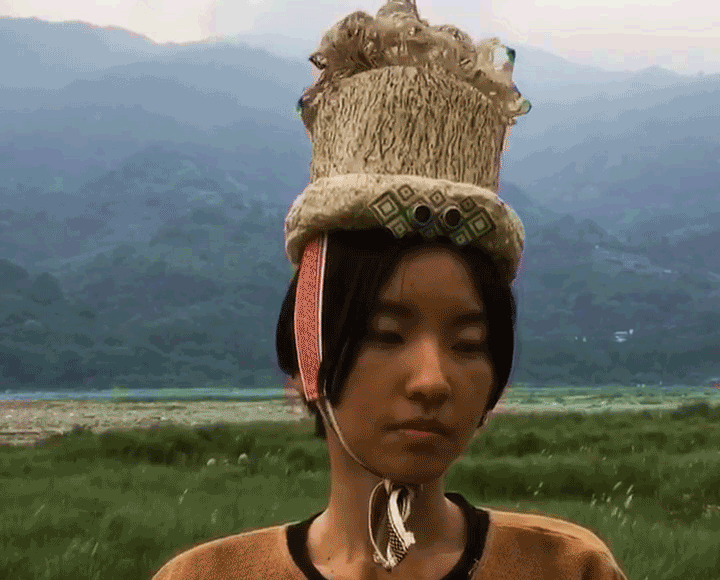Atayal Modern Times - Camouflage Suit by Chanee Choi
In the Summer of 2018, I visited Wulai, the Atayal (泰雅族) village to participate in the ‘Tribe Against Machine e-Textile Summer Camp,’ for cultural exchange and skill-sharing. The Atayal is the third-largest indigenous group in Taiwan. The village appears similar to an average Chinese village, but the heritage and tradition unique to this indigenous group is carefully preserved by the inhabitants. During my time with the Atayal, I studied the culture and history of the indigenous female weavers, who suffered under Japanese colonization from 1895 to 1945.
The picture from: http://iwri.org/taiwans-indigenous-peoples/
During the occupation of Taiwan, the Japanese colonial government banned the Atayal from engaging in their most important socio-cultural activities, such as facial tattooing, headhunting, and weaving. This ban led to the confusion of identity signals among the Atayal because facial tattooing indicated both the career and the maturity of the bearer. While Atayal men earned their tattoos by successfully hunting heads, Atayal women earned theirs through the mastery of weaving. It was said that only the tattooed could safely pass into the afterlife. Under japanese rule, Atayal women forgot many of their weaving skills and a large proportion of their original textiles were taken to Japan. Despite the appreciation for their beautiful textiles, the Atayal people and their traditions were labeled barbarian. This sense of cultural superiority helped the Japanese to justify the forced displacement and assimilation of the Atayal as well as the clearcutting of their forested homeland, the aftermath of which led to the moral devastation of the Atayal people.
As I began to build an understanding of the identities of Atayal female indigenous weavers and Japanese occupation period, I imagined how the Atayal weaver who needed to hide their identity might have impersonated a modern civilian in imperial countries like Japan without allowing their culture and history to vanish. The Jacket and the Hat would have appeared ‘civilized’ to viewers at the time, as the style of dress in Japan during the Meiji era was heavily influenced by European design.
Family picture of 1930’s Taiwan
Man in Suit, Photo from New York Public Library.
So, like the white rabbit in Alice’s Adventures in Wonderland, who dressed to serve an irrational queen, I imagined that I wore the regency gentleman’s jacket and top hat. I would not look like a barbarian to my Japanese colonizers as the outfit would work as camouflage, hiding my original identity behind the appearance that society would have accepted--- but this camouflage is also that of a hunter. The inside of the jacket references the traditional Atayal garment pattern for the hunting: the design of the armpit is flexible and open to suit the requirements of hunting in the mountains. The hat’s ribbon tie is references the facial tattoos of Atayal master weavers, which were done on the cheek, typically from the ears across both cheeks to the lips, forming a V-shape.
Traditional Atayal facial tattoo.
In this project, I imagine that the Atayal are still living under Japanese colonial rule. I explore how they may have related to post-internet art theory and how this might have affected the development of their fashion, considering the safety and freedom of invisibility within systems.
For the hat’s material, I made the traditional handcraft paper from the mulberry trees in the village. I used aluminum meat tenderizer to expand the tree’s bark to make the paper from it. And then I made a hat using a cylinder shape then I can make a regency hat shape. For the jacket’s fabrics and the hat’s ribbon, I got supported the handmade Atayal fabric, traditional patternized ribbon from Yuma Taru, who is the recipient of the National Living Treasure award in Taiwan.
The hat is made out of traditional paper that I handcrafted from the bark of the mulberry trees in the village. For the jacket’s fabrics and the ribbon on the hat, I used handmade Atayal fabric. I sourced a traditionally patterned ribbon made by Yuma Taru, who is a National Living Treasure in Taiwan and re-printed the ribbon’s pattern using Yuma’s industrial embroidery machine, mixing the traditional handcraft with new technology.
I embroidered an Atayal ribbon pattern using Yuma’s industrial embroidery machine so I can reproduce the traditional handcraft to the new technology. I put them on the hat’s band.
Inside the hat there is a built-in motion sensor, so the wearer can hide themselves in the forest, covertly preserving their culture and identity by deceiving passing Japanese colonists. The grasses and flowers at the top of the hat are connected to motors that adjust the speed of the rustling foliage depending on the distance of the stranger. The jacket lights up with LEDs when the proximity of a stranger is noticed and makes camouflaging sounds through a micro speaker.
Made flower shape using a mulberry paper
Ultrasonic sensor connected with servo
Adafruit flora controlled the hat and the jacket.
References:
Gi-Wook Shin and Michael Edson Robinson, 1999. Colonial modernity in Korea. Harvard University Asia Center: https://hdl-handle-net.offcampus.lib.washington.edu/2027/heb.02416
H. G. Wells, 1896 [1994]. The island of Dr. Moreau. Bantam Classics, New York, USA.
WEAVING ASIAN IDENTITY MARKER: ATAYAL WOMEN IN WULAI, TAIWAN: https://duwamish.lib.washington.edu/uwnetid/illiad.dll?Action=10&Form=75&Value=1765023
Weaving and Identity of the Atayal in Wulai, Taiwan: https://uwspace.uwaterloo.ca/bitstream/handle/10012/3354/MamiYoshimura_MAThesis.pdf?sequence=1&isAllowed=y
Yuma Taru: https://taiwantoday.tw/news.php?unit=18,23,45,18&post=24402: http://np.cpami.gov.tw/scholars-experts/4967-yuma-taru-02.html
Documentary film on Korea’s colonization by Japan: https://www.youtube.com/watch?v=rrs7bvcw7gw
June 2019
Model: Sheri shih hui chang
Photo: Kestin Mica
Collabo with: Nukeme
Material Support: Yuma Taru, National Living Treasure in Taiwan
#atayal #camoflagesuit #atayaldress #atatalnewdress #chanheechoi #chanheec #chaneechoi #chaneec

















